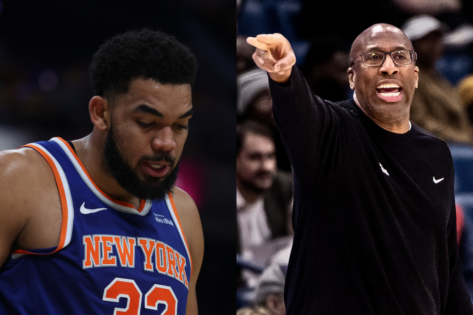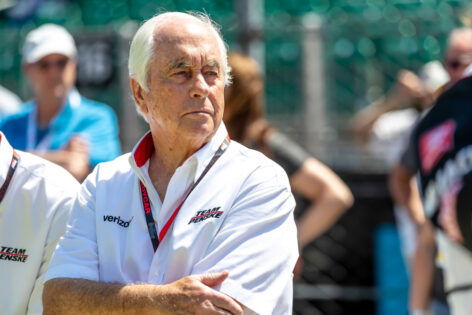In his introductory interview with the Knicks, Mike Brown hinted at his core coaching belief: “You have a philosophy on both ends of the floor that you have to make sure fits with your personnel.” It’s a principle he’s applied everywhere he’s coached — from molding Cleveland’s defense around LeBron James to maximizing the strengths of Domantas Sabonis and De’Aaron Fox in Sacramento.
The New York Knicks have arrived at a pivotal juncture. Despite the shocking fire of Tom Thibodeau, they’ve built a contending roster, made it to the Eastern Conference Finals, and added Karl-Anthony Towns to a core that includes Jalen Brunson, Mikal Bridges, and OG Anunoby. But as training camp looms, one central dilemma clouds the path forward.
Mike Brown has inherited a unique roster with one glaring question: Can the Knicks maximize both Karl-Anthony Towns and Mitchell Robinson without compromising the system? Robinson is the team’s best rebounder and only true rim protector. He was a game-changer defensively in the playoffs, anchoring New York’s zone and closing crucial games with raw hustle, elite positioning, and physicality around the basket. His playoff performance against Boston, restricted them only 80.2 points per 100 possessions with him on the floor. In the last two of three postseasons, Robinson lead in offensive rebounds.
Towns, on the other hand, is a floor-spacing offensive machine. He averaged 24.4 points, shot 42% from deep last season, and commands double-teams on the perimeter. His fit with Brunson has the potential to elevate New York’s half-court offense to elite levels. But defensively, Towns struggles to contain quicker bigs and has often been a liability in drop coverage.
Jan 12, 2025; New York, New York, USA; New York Knicks center Karl-Anthony Towns (32) reacts during the first quarter against the Milwaukee Bucks at Madison Square Garden. Mandatory Credit: Brad Penner-Imagn Images
Together, their strengths are complementary, but the pairing hasn’t yet proven sustainable. In 98 minutes shared with Towns and Brunson, the Knicks surrendered a bloated 117.3 points per 100 possessions. The combination can work in bursts, but New York hasn’t yet found a way to make it last for full games or series. That’s the battle Mike Brown now finds himself in. And while Robinson is one of the most impactful defenders in the league when healthy. He allows the Knicks to switch everything, frees up wings like Anunoby and Bridges to be aggressive on the perimeter, knowing there’s coverage behind them.
But spacing is non-existent when he’s on the floor. Robinson hasn’t made a jump shot in years. He doesn’t draw attention on offense, which makes things tighter for Towns and Brunson to operate. In a five-out offense, what Towns thrives in, Robinson clogs the paint. His defender sits back, taking away lanes and undercutting any dribble penetration. Even with the upside of their jumbo lineup, the Knicks outscored opponents by 8.3 points per 100 possessions in the playoffs when Robinson and Towns shared the court, there’s a limit to how long it can hold up. One foul-prone game from either can derail it. One floor-spacing matchup can stretch Robinson out of his comfort zone.
Mike Brown must make an important decision
Brown’s defensive philosophy is both flexible and foundational. The flexibility lies in adapting schemes to fit his roster, while the foundation rests on defensive intensity, sharp communication, and full accountability. In Cleveland, he leveraged LeBron’s versatility to switch seamlessly between guards and bigs, while using Anderson Varejao in drop coverage to protect the paint. He also built a culture of effort, with LeBron later praising Brown’s demanding “no-excuses” defensive drills.
When the Knicks begin training camp, big questions loom. Will Mike Brown alter the starting five that sputtered down the stretch last season? Will he try to fix the defensive issues that arise when Brunson and Towns share the court without rim protection? And perhaps most crucially, what is Mitchell Robinson’s role and future with this team?
Robinson is entering the final year of a four-year, $60 million contract. He has an affordable deal and high trade value. But the injury concerns remain significant, and his role is shrinking. Robinson hasn’t played more than 59 games in a season since 2021. He missed 65 games in 2023–24. He was absent for much of the previous year. Even after offseason surgery in May, Robinson only returned to contact drills this August. And he’s still without a target return date for full 5-on-5. He averaged just 17.1 minutes in 17 games last season.
The Knicks need him in playoff moments, no one else on the roster can credibly guard Joel Embiid or Giannis. But they also need more reliability throughout the regular season. Trading Robinson could net multiple rotation players or a healthy backup big. Still, with Towns and Robinson, the Knicks can deploy a double-big lineup that wrecks the glass, controls the paint, and allows Anunoby and Bridges to wreak havoc. But they’ll need to stagger it carefully.
Chris Herring nailed the situation,“Still, there are flaws in assuming Robinson can clean up everything. The Knicks need to be careful in extending his minutes given his injury history… the datapoint suggests Brown would have his work cut out in blending things for the 2025-26 season.”As the Knicks move into training camp, the answers won’t come easy. Brown will need to find creative ways to use Robinson sparingly but impactfully during the regular season. That means finding rotations where Robinson’s defensive brilliance can shine without crushing floor spacing. And it means managing Towns’ minutes when playing solo as the five, where he’s offensively lethal but vulnerable on defense.
The post Mike Brown Battles Karl-Anthony Towns Dilemma as Knicks Face Key Roster Decision appeared first on EssentiallySports.



